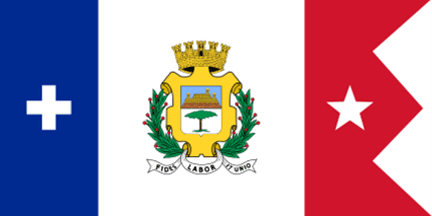 image by Daniel Rénteria, 3 August 2022
image by Daniel Rénteria, 3 August 2022
Last modified: 2022-09-10 by rob raeside
Keywords: cuba | cienfuegos |
Links: FOTW homepage |
search |
disclaimer and copyright |
write us |
mirrors
 image by Daniel Rénteria, 3 August 2022
image by Daniel Rénteria, 3 August 2022
See also:
I found at www.cienfuegos.cu the
flag of Cienfuegos City. Info in Spanish as follows:
"Fue disenada, pintada y bordada por la primera poetisa
nacida en Cienfuegos, Clotilde del Carmen Rodríguez López, para
su amigo Germán Barrios Houard, cuando los cienfuegueros
secundaron la guerra de Yara en febrero de 1868.
Está formada por tres franjas verticales, azul la primera de
ellas, blanca la segunda y roja la tercera, como las de la
bandera francesa, recordando el origen galo de Fernandina de
Jagua.
Pero, sobre este fondo tricolor, tiene algunos símbolos que las
diferencian: En la franja azul, una cruz equilátera blanca que
recuerda la religión cristiana; en la blanca, el escudo local y
en la derecha aparecen tres triángulos rojos con una estrella
blanca en el centro, didimulados por dos blancos que los
flanquean."
Falko Schmidt, 26 October 2001
The Homeland (Cuba) was under the cruelest Spanish colonial
repression, when beginnings of 1869, the Cienfueguerian Patriot
and Poetess Clotilde del Carmen Rodriguez Matamoros, well-known
as "La Hija del Damujě" (Daughter of Damují)
designed, painted and embroidered the flag of Cienfuegos, with
the noble intention to give it to the members of the
Revolutionary Council, which they were conspiring and disponing
to support the insurrection would be leaded by Carlos Manuel de
Cèspedes, on October 10th, 1868. Our local flag is formed
by three vertical stripes; blue first of them (something narrower
than the other two), white the second one, and red the third one.
That is to say, same colors of French Flag, representative of
Gallic origin of Fernandina de Jagua Colony; nevertheless, some
symbols are observed on this tricolor field, which differentiates
it of National Flag of France. On the blue stripe (left)
rebounds a white equilateral cross which remembers the Christian
religion. In the center one, white, appears the Coat of Arms of
the City, designed by Don Agustín Santa Cruz on 1831. The right
stripe, red, presents three insinuated triangles with a star on
the center, disguised by two white triangles that flanks it.
On February 6/7th, 1869 was hoisted on the rebel field by
the revolutionary Germàn Barrio Howard, lieutenant colonel and
Cheif of General Staff of general Adolfo Fernandez Cavada. It's
says that Mrs. Clotilde Ramos Rodriguez Matamoros design the Flag
because the insurgents of the Revolutionary Council lacked a
symbol that identifying them.
Maikel Arista-Salado (translated by Raul Orta),
3 November 2004
I spent some time in the beautiful city of Cienfuegos and I could see there
one of the two local flags I saw in Cuba (the other one being La Havana), and
this one was proudly flying in the wind
on the city hall.
Olivier Touzeau, 13 March 2011
The proportions are the same as the flag of Cuba and the coat of arms is more
commonly seen in a different style (as you can see in the images I have
attached)
Other images:
http://www.5septiembre.cu/simbolos-locales-la-bandera-de-cienfuegos/
https://www.cibercuba.com/noticias/2017-07-15-u73624-e73624-bandera-cienfuegos-insignia-presencia-francesa-cuba
Daniel Rénteria, 3 August 2022
cienf.gif) image
by Blas Delgado Ortiz, 6 November 2001
image
by Blas Delgado Ortiz, 6 November 2001
Info in Spanish at
www.cienfuegos.cu
as follows:
"Es cuadrilongo y está dividido en dos cuarteles. En el
superior, sobre el campo azul, aparece el frente dorado del
Castillo de Jagua, y en el inferior, sobre el campo de plata, una
jagua en producción; lo rematan una corona mural de cinco
castillos y dos ramos laterales de laurel.
Este símbolo fue disenado por Don Agustín de Santa Cruz en
1831, y fue adoptado por nuestro Ayuntamiento el 4 de julio de
1848 al serle concedido a la Villa de Cienfuegos el derecho a
usar escudo de armas por la Real Orden de Isabel II del 2 de
abril anterior. Su lema: Fe, trabajo y unión, en latín: Fides,
Labor et Unió, fue adoptado por los fundadores en la manana del
22 de abril de 1819."
Falko Schmidt, 26 October 2001